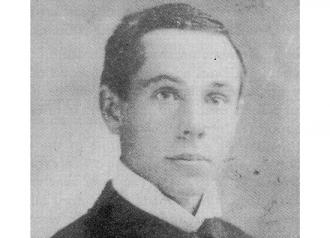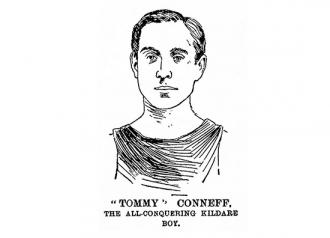'The little Irish wonder': Ireland's greatest unknown athlete
Toggle
There will be no Olympic Games this summer, but we look forward to Tokyo in 2021 when we will hopefully be able to marvel at Irish performances. Back in the early 1890s, on the eve of the first modern Olympiad, international newspapers marvelled at the prowess of a Kildare born athlete who was taking the sporting world by storm. In the 1880s and 1890s, he was an international athletic sensation, setting and breaking several world records. Many of these records remained unbroken for many years after his death, some indeed for over 50 years.
The man in question was Thomas Conneff, born in 1866 near the village of Clane and in the shadow of Clongowes Wood College. Such was his prowess that James Joyce includes Conneff as one of the heroes of Ireland in Ulysses. Joyce, of course, was a student of Clongowes towards the end of the century and was thus heavily influenced by local sports. Conneff enjoyed international celebrity akin to what modern day stars such as Lionel Messi, Roger Federer and Usain Bolt do.
The Clane years
Conneff was the son of James and Marcella (nee Rourke), of Kilmurry, Clane, Co Kildare. The Conneff family were blacksmiths and the Jesuit College at Clongowes may have provided regular work. In his early teens, Conneff received instruction in athletic training from local sports enthusiast, Charlie Farrell of Ballinagappa, Clane.
He first came to prominence in the mid-1880s in the local athletic meetings at Clane, Kilcock and Carbury, when such competitions were regular features of the emerging Gaelic Athletic Association. However, his early career was shrouded in controversy as he was engulfed in the struggles and disputes which existed between the GAA and the Irish Amateur Athletic Association. On one occasion, Conneff was prevented from competing at a race meeting when a dispute arose as to what rules would govern the event.

"Conneff's success was all the more remarkable considering the fact that he was said to have disliked training"
In 1886, Conneff represented Haddington Harriers and won the half mile at the Caledonian games at Ballsbridge, and the Irish Amateur Athletic Association Championships at 880 yards and mile flat. Victories quickly followed at races in Mullingar, Newbridge and Wexford. The following June, now attached to Inchicore Gaelic Club, he secured a hat-trick of victories in the 880 metres, one mile and two miles at Limerick. A month later, the Irish Amateur championships was again won by him in a new Irish record time of 20 minutes and 55.45 seconds.
Around then, Conneff was working in the commercial department of the Freeman's Journal, a newspaper with an immense sporting interest in the 1880s. In August 1886, with the encouragement of sports editor Fred Gallagher who saw his potential, Conneff went to the North of England championships in Liverpool. The event over steeples took place before an estimated crowd of 40,000 people and Conneff defeated the English Champion, F. Mills, and the visiting Anglo-American 'wonder’ E.C. Carter.
Unhappy with the result and seeking a rematch, Carter agreed to come to Ireland later that month to meet Conneff in what the Freemans Journal called "the race of the century". Over 20,000 spectators turned out at Ballsbridge to see it and Conneff again won, much to the delight of the home support with the Journal dubbing him "the athletic marvel of the age".
America calling
After an invitation from the Manhattan Athletic Club, Conneff decided to go to America to challenge the best international athletes of the day. Before departure, the William O'Brien’s GAA club in Clane held a meeting to present an address to the departing Conneff. "We hope that in breasting the tape in front of the best runners that America or the rest of the world can provide, you will remember that in the Green Isle beyond the sea, there will be hearts beating eagerly for the gladsome news that our little champion has won again. God speed you on your journey and long may you live to bear the title of the champion of the world".

In America, the Kildareman quickly established himself and won the mile and five mile races against the GAA Invasion teams of 1888 at Madison Square Gardens. He quickly added the American title for the five mile, and retained it for the following three years, as well as taking the two and ten mile titles.
In 1890, he won the US 15km road race and the Canadian two miles in record time. In 1891, he reduced the American mile record to 4 minutes 21 seconds and ran it in 4 minutes 17.8 seconds two years later. He annexed the American titles for the mile and five miles at New Orleans, while he broke the world record for the mile at the Boston Games in August 1893.
Why did he stand out?
Much was made of the fact that Conneff favoured running spikes which was said to have given him an advantage over other competitors. The knowledgeable track reporter, and former athlete, Malcolm W. Ford contrasted him with the taller runners who typified the middle-distance fraternity in the early 1890s: "Conneff stands five feet five tall and weighs 127 pounds in running condition. He possesses a rather big body, which has a large capacity for vital organs. His arms are noticeably stout for a distance runner. He moves with a light, springy action that takes him over the ground without giving the impression that any effort is being used.... There are but few distance runners who combine the staying power, grace and speed of Conneff."
Conneff's success was all the more remarkable considering the fact that he was said to have disliked training and did not race for a period in America. He returned home to Ireland in 1892 while suffering from typhoid, spending three months in Richmond Hospital, Dublin and a long period of convalescence in his native Clane.
I have often thought that the secret of my success to a great extent lies in the fact that I punished myself more than other men
Returning to America, he seems to have abandoned athletics and was working in New York. When the first ever international match between America and England was fixed for 1895, Conneff was persuaded to make a comeback. Trainer Mike Murphy put him on a strict three month training regime and, much to the astonishment of the sporting world, he won the race in style. It was, according to Caspar Whitney, athletic authority for Harper's Weekly, the most remarkable performance ever seen on an American track. However, signs of demise were evident when Conneff was carried off the field with exhaustion.
His success continued in 1895 when he lowered the world best for the mile at the Labor Day games of the New Jersey A.C by over seven seconds. Conneff also tried his hand at indoor running and broke the world indoor record in Boston in January 1896. His final appearance in New York a week later, however, was an abortive attempt on the US 10 mile record, which ended with a case of sore and blistered feet after five miles on the boards at Madison Square Garden.
The final lap
Undeterred, Conneff made the decision to turn professional in 1896, which perhaps prevented him from attending the inaugural Olympic Games. Although suffering from malaria, he competed against F.E. Bacon in three high profile races watched by crowds of over 10,000 people including Theodore Roosevelt at Old Worchester Oval, Massachusetts. Bacon won all three races convincingly. Returning to full health, Conneff challenged George Blennerhasset Tincler, the son of a Dublin solicitor and law student at Trinity College, to a race. Nicknamed the Gander for his awkward posture, Tincler easily defeated a now failing Conneff. In a rematch, which he requested, Tincler even afforded him a 25 yard head start but Conneff could not cope with the power of the ‘Gander’ in what proved to be his final race.
When the Spanish-American war broke out in 1898, Conneff enlisted in the US Army and saw service in Cuba, Puerto Rico, St Michael’s, Alaska and the Philippines. When the war finished, he was stationed in the Philippines and deployed as a clerk to Troop E of the 7th Cavalry. It was there that he was found drowned in the Pasig River on October 10th 1912. As Conneff was a competent swimmer, mystery surrounded his death. In 1916, his one time athletic adversary E.C. Carter wrote that he had met his end by "foul means".
There are but few distance runners who combine the staying power, grace and speed of Conneff
Throughout his career, Conneff was given many titles including "the little Irish wonder", "the speedy son of Erin" and "Tommy of the bulldog heart and greyhound legs", while records set by him were often referred to as the "Conneff mark". When asked about the secret of his success, Conneff said "I have often thought that the secret of my success to a great extent lies in the fact that I punished myself more than other men. I go the first quarter on my speed. By the time I reach the half I am getting quite weary. At the three quarter pole I feel dead to the world but I go another quarter because I have to and because I make myself do it."
That Conneff never ran in the Olympic Games probably assigned him to the pantheon of forgotten stars. Today, he is commemorated in Clane where the local GAA grounds are named in his honour, but many are unaware of what he achieved in his lifetime. Thomas Patrick Conneff is buried in the San Francisco National Cemetary near the Golden Gate Bridge.
